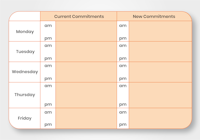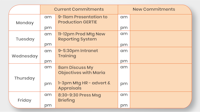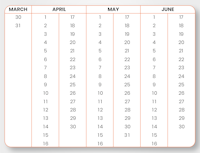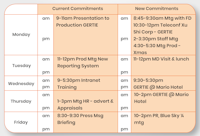In-Tray Exercise Guide and Practice Tests
All products and services featured are independently selected by WikiJob. When you register or purchase through links on this page, we may earn a commission.
- What Skills Are Being Tested With an In-Tray Exercise?
- What is an In-tray Exercise?
- What is E-Tray Exercise?
- In-Tray Practice Test (2025)
- How an In-Tray Exercise is Structured
empty
empty
empty
empty
- How to Approach the In-Tray Exercise in 2025
- Succeeding at the In-Tray Exercise: Key Tips
empty
empty
empty
empty
empty
empty
- How You Will Be Assessed On The In-Tray Exercise
empty
empty
empty
empty
- The In-Tray Justification
empty
empty
empty
- In-Tray Exercise - Example Justification Questions & Tips
empty
empty
- Justification Tips for Success on the In-Tray Exercise
- In-Tray Practice Tests (2025)
- Overview for In-Tray Practice Exercises
- Hints & Tips on How to Use the In-Tray Overview in 2025
empty
empty
empty
empty
empty
empty
empty
- In-Tray Exercise Practice Tests
- Frequently Asked Questions
- Final Thoughts
What Skills Are Being Tested With an In-Tray Exercise?
The in-tray exercise is a major component of most assessment centres because of the variety of skills, knowledge and attitudes that can be tested.
The reason that the in-tray exercise is so widely used is that it allows the assessors to observe a candidate’s behaviour during the exercise. This is fundamentally different from an interview, in which candidates are predominantly judged on what they say.
The behaviour shown during the in-tray exercise will then be compared to the key behavioural criteria that have been specified for that role.
Always remember that in-tray exercises are designed to judge how well you exhibit the required behaviours of the job you are applying for. This is by assessing to what extent you can:
- Exhibit the correct level of knowledge
- Display the right type of skills
- Demonstrate the attitudes of the role
Within the human resources industry, these are commonly abbreviated to KSAs – knowledge, skills and attitudes.
An in-tray exercise is a paper-based simulation used to assess the aptitude of potential employees as part of the employment selection process. E-tray exercise is the same thing but computer-based.
What is an In-tray Exercise?
An in-tray exercise is a paper-based simulation used to assess the aptitude of potential employees as part of the employment selection process. E-tray exercise is the same thing but computer-based
Candidates will be presented with a business-related scenario, accompanied by a list of related tasks including telephone calls, emails, complaints and reports. It is then up to the individual to prioritise each task in accordance with its perceived importance.
In-tray and E-tray tests are used by many companies as part of the selection process and they commonly appear as part of the interview stage.
Please note, an in-tray exercise and an in-basket exercise are similar assessments and assess similar skills, however, an in-tray exercise focuses on tasks completed in its own workspace (e.g. email management).
Whereas, in-basket exercise also focuses on tasks in a shared workspace (e.g. phone calls, inter-department communication).
For the in-basket test you can practise in-tray exercise as well.
What is E-Tray Exercise?
An E-Tray exercise, also known as an e-tray assessment or e-tray test, is a type of situational judgment test often used in the context of employment assessments, especially for roles that require strong organizational and problem-solving skills.
This type of assessment is commonly used by employers during the recruitment and selection process to evaluate a candidate's ability to handle work-related scenarios and tasks in a simulated electronic format, typically resembling an email inbox or digital workspace.
As a candidate, you can’t afford to leave anything to chance or assumption during the in-tray exercise. Your assessor can only give you credit for the knowledge, skills and attitudes (KSAs) that you exhibit during the exercise. So, if you know it, you have to show it.

In-Tray Practice Test (2025)
Take this free in-tray test before reading on:
Assume you are Margaret Johnson, working as a Store Manager for the departmental chain Garrods in Plymouth.
- Teresa Sputnik is your manager.
- John Statham is your deputy as the Assistant Store Manager.
As you start the day on 21st September 2020, a Monday, you find the following set of emails in your inbox:
MAIL 1:
From: Phil Collins, Store Intern
Date: 19.09.2020
Subject: URGENT: Leave Request
Dear Madam,
I have been diagnosed with a severe bout of flu. The doctor has advised complete bed rest for a week. May I request you to kindly grant me leave of absence from 20/09/2020 to 25/09/2020.
I will update the leave request on the company intranet HR portal once I am back in office.
Thanking in anticipation,
Yours faithfully,
Phil Collins
Emp Id: 908102
MAIL 2:
From: Susan Woodsworth, Internal Auditor
Date: 21.09.2020
Subject: Audit Committee Concern
Dear Ms Johnson,
On behalf of the corporate team entrusted with the ongoing Quarterly Fiscal Audit, I would like to raise concerns regarding absence of requisite support from your store team. Please note, we have not seen any representation from your team in the last two weekly core group meeting held every Friday.
Furthermore, my mails dated 06/09 and 13/09 sent to John Statham, Assistant Store Manager, Plymouth, asking for detailed clarifications against ‘Sundry Other Expenses’ and ‘Discretionary Spending’ are as yet not responded to (ref. attachments #1 & #2).
Would appreciate if you could kindly check and revert by EOD today. Otherwise, we would be constrained to raise this in the Steering Committee meeting with the MD on 23rd.
Regards,
Susan Woodsworth, CA, CFA,
Lead, Quarterly Fiscal Audits,
Regional Audit Team, UK Operations
MAIL 3:
From: Derreck Cottonball
Date: 21.09.2020
Subject: Feedback Request
Dear Sir/ Madam,
The first consignment of our premium organic cage-free chicken eggs has just reached your store over the weekend. We would appreciate if you could share your feedback on the ease of doing business with us and quality of service by responding to our online survey (it would take 5 minutes, we promise!):
We treasure your continued patronage.
Yours sincerely,
Derreck Cottonball
Account Manager, Corporate Sales
CageFreeChicks Ltd., UK
MAIL 4:
From: Samuel Gonzales, Corporate HR
Date: 21.09.2020
Subject: Resource Planning
Margaret,
Would it be possible for you to attend a quick call regarding resource planning for the next quarter slated for 04:00PM today? Steven from the Chairman’s office would like to address all store managers and senior staff.
Sorry for the short notice!
Sam
MAIL 5:
From: Teresa Sputnik, Regional Manager
Date: 21.09.2020
Subject: Slow Moving Merchandise
Prepare a summary on the following:
- Root cause for low sales figures for leisurewear (both male and female) for August
- Reason for increased returns in household electronic category in August
- Forecast demand for pre-cut vegetables for November-December
We need to share it along with the weekly status report this Wednesday. Let us discuss the points around 5PM today.
Thanks.
MAIL 6:
From: Training & Induction
Date: 18.09.2020
Subject: Training Calendar
Dear All,
Please share the training requirements for your respective store staff by 25th September. The training calendar for October is attached herewith.
Thank you.
Sincerely,
Terry Oswald
Corporate Training
MAIL 7:
From: Corrie Magdalene
Date: 21.09.2020
Subject: Will be late today
Ma’am,
I will be late today due to some unforeseen personal exigencies. Have already called John and updated him. This is to keep you informed.
Regards,
Corrie Magdalene
MAIL 8:
From: Teresa Sputnik, Regional Manager
Date: 21.09.2020
Subject: Call
I think one of the figures we prepared to present in tomorrow’s executive review meeting is wrong. Can you call urgently once you are in office.
Teresa
Which email would you prioritize first?
Practice In-Tray Test with JobTestPrep
How an In-Tray Exercise is Structured
In-tray exercises can take a variety of formats.
The two most popular are:
-
You are given between 12 to 30 in-tray items that you have to prioritise and action. This is done by answering a series of multiple-choice questions.
-
You are given between 12 to 30 in-tray items which you have to prioritise and action. This is followed by an interview with an assessor in which you are expected to justify your decisions.
During the in-tray exercise, you will usually be asked to assume a particular role as an employee of a fictitious organisation and work through a pile of correspondence in your in-tray.
What Does In-Tray Measure?
The in-tray items will be specifically designed to measure job skills such as:
- Ability to organise and prioritise work
- Analytical skills
- Communication with team members and customers
- Written communication skills
- Delegation
Your brief might be something unexpected. For example, you may be told that it is the first day of your new job as a deputy headteacher and given a list of thirty tasks and memos to prioritise and action. This type of scenario may occur even if you are applying for a job that has nothing to do with education.
Don’t make the mistake of worrying about the topic. You will be judged on how well you can handle complex information, determine priorities, make decisions within time limits, display sensitivity to potential problems and communicate clearly.
The type of issues you will be asked to review and action will usually reflect the nature of the role you have applied for. Remember, this does not necessarily mean that the scenario will be based on your industry or sector.
In-Tray Exercise Examples
-
If you are applying for a strategic role, then it's likely that a significant number of your in-tray test items will be designed to test your strategic decision-making.
-
If you are applying for a management role, the in-tray test items are more likely to raise issues about team-building, coaching, motivation and other management issues.
What to Expect
For the majority of in-tray exercises, you will be given the following information:
- Details of your role and responsibilities
- Key issues and objectives of the organisation
- An organisational chart or description
- A list of the staff that report to you (where applicable)
- A list of key employees that you may need to interact with during the exercise
- Third-party relationships and activities
- A calendar of the next two to three months
From the data you are supplied with, you must extract the necessary information that will form the basis of your decision-making during the exercise. During your preparation for the in-tray exercise, it is important to keep in mind the knowledge, skills and attitudes your assessors will be looking for you to exhibit.
Length and Intensity
If you are applying for top-level management or strategic roles, you will find that the in-tray exercise is longer and has a greater intensity than those aimed at lower-level jobs. You may find that you are required to produce written responses.
As the intensity of the exercises increases, the likelihood of being able to complete the whole exercise in the allocated time diminishes. It is how you respond to the major issues that matters, rather than completing the whole exercise (though the latter should always be your goal).
For some candidates, their in-tray exercise could be up to three hours in length. This is frequently done in two or three sections, which are fitted around the other exercises you undertake during the assessment centre.
Be assured that all candidates will have the same experience, so that you can all be scored fairly.
Take a Free In-Tray Practice Test
How to Approach the In-Tray Exercise in 2025
There are several things you can take into the assessment centre that will make the task of sorting through in-tray items easier and faster.
These include:
- Coloured pens
- Pencil
- Eraser
- Highlighter pens
- Post-it notes
- Scrap paper
- Calculator
You could, for example, mark items that are urgent with a particular colour, thus saving time when sorting through them. You will need to develop your own system for classifying items which is something that you can do using the practice tests.
Below are some step by step tips on how to approach key aspects of the in-tray exercise. If you want to start practising immediately, try these in-tray tests.
Step 1. Prioritising
You must work in a way that maximises the score you can achieve. Some items will be far more important than others; the assessors want to see how you deal with these items and how your approach fits in with the ethos and values of the organisation.
Read Thoroughly
Before you start, read through the information that you have been provided with thoroughly, so that you fully understand what is required.
To avoid missing any important items, the best approach is to work quickly through all of the items and determine the urgency and importance of each one. You can then use the 80/20 rule to apportion your time between the items. This means that you will use 80% of the time available to work on the most important items and then 20% on the less significant and mundane items.
Time Management
Always keep in your mind how much time you have in the scenario to deal with each item.
First, you should scan through each of the items quickly and sort them into chronological order. At the same time, look out for items that are interdependent, or items which make a previous item redundant.
Organization
This is an important step, as you don’t want to waste time with items that have been superseded and therefore don’t need to be actioned. Also, you may think you have quickly solved one problem only to find that a memo sent three days later has added a further complication, which makes your original decision unworkable or impractical.
You may want to put the items into three piles using a post-it to identify each one:
- Urgent
- Important
- Routine
For each of these piles, you can then segregate them further by who is to deal with them:
- Myself
- Delegate to [name]
- File
Or, you could organise them based on a time frame:
- Next hour
- Today
- Tomorrow
- Later
If you are using a time frame as a method of prioritising then you may wish to use the diary sheets or calendar (if provided), or create your own to make notes on, so that you can easily see an overview of the situation.
Your calendar does not have to be elaborate. A simple grid like the one shown will be sufficient:

Schedule
You only need to be able to see the days of the week, since you can then mark in significant appointments and actions. In this way, you can easily see any double bookings you have as a result of the change outlined in the overview.
You can also use these sheets to show how and when you’d request essential reports needed for a meeting, or monitor certain actions or delegated tasks. In this way, you provide the assessors and yourself with a written record of how you approached the exercise.
This is particularly useful to refer to if you have a face-to-face meeting with the assessors following the exercise, as it's very easy to forget why you made certain decisions.
Step 2. Identifying Key Information
Use your highlighter to identify key information you have been given:
- Who you are
- Your function
- Type of organisation (government, industrial or non-profit)
- Recipient and how they relate to you
- The date on the item in relation to today’s date
- Dates of meetings & deadlines
Step 3. Keeping Records
Remember to keep detailed notes of your thought process as you work through the exercise. This is especially important if you are expected to justify your decisions, possibly in a separate justification interview after the test.
For example, if your response to an item is to delegate a task to one of your staff, the assessors will want to observe how you perform this and how well it matches the organisation’s expectations. Do you provide a clear brief of the task requirements, details of the desired outcomes and a deadline?
The assessors will also want to see how you would monitor progress. This could take the form of a note in your diary or planner.
Step 4. Diversions and Problems
Sometimes details contained in your role overview may consciously try to limit your ability to respond to assess how you deal with such a situation.
An in-tray item may say that you or your manager are uncontactable for a week. This infers that you or your boss are unable to make or receive calls, but it doesn’t necessarily mean that you can’t call in or contact them either by phone, text, fax or email.
You will need to carefully read the brief and make sure of exact meanings. Don’t be put off by minor diversions created in the brief.
Step 5. Financial Information
If you are asked to assess some financial information, make sure that all the details you’d need to respond are detailed on your in-tray item.
For example, you may be asked to solve a problem with an invoice, but the date of the order and/or the order number are missing. You would need to ensure that the invoice you had in your in-tray was actually the one that created the problem.
Step 6. Communication and Tone
Make sure that the tone of any communication is compatible with the ethos of the organisation. The item itself may be insignificant or unimportant, but the tone of the item may need to be addressed.
You must also be able to show that you are understanding and empathetic with others. If you come across as totally focused on getting the job done it may be detrimental. Remember, view your actions in the context of the role you are performing in this in-tray exercise.
If you need to prepare for a number of different employment tests and want to outsmart the competition, choose a Premium Membership from JobTestPrep.
You will get access to three PrepPacks of your choice, from a database that covers all the major test providers and employers and tailored profession packs.
Succeeding at the In-Tray Exercise: Key Tips
Here are some important tips to bear in mind:
Practice
You must practice to improve your chances of achieving a maximum score.
With practice, you can learn to see which specific in-tray items are testing which of your skills, and learn how best to respond to the problems and issues they raise.
Try out some practice tests from JobTestPrep here.
Make Notes
You should check whether you can write notes on the in-tray items themselves. If you can, then do so.
Be consistent in where you write your notes, so that you can easily review them; for example, always in the bottom right-hand corner.
Remember that everything you do must maximise the time you have available.
Be Organised
When you are working through the items in an in-tray exercise, always try to be as logical and systematic as possible.
The information may be presented haphazardly, but you don’t want to be seen to work haphazardly. Be mindful of how your desk or work area looks during and at the end of the exercise.
Annotating or using post-it notes to identify items will greatly enhance your efficiency and help you to keep things under control.
Do not make assumptions
It is important to make your decisions based only on the information provided. Assessors will want to see how well you evaluate the information supplied and will assess the appropriateness of your decision based on the scenario.
Be wary of falling into the trap of selecting an answer that you would normally want more detailed information about before making a decision. If appropriate, your answer could be ‘None of the above’ or ‘I’d want to delay my decision until I had more information’.
Watch out for Bulk Filler
These are attachments, brochures and reports that are included within an in-tray item but do not add further information or clarity to the issue raised. You will not have enough time to review such things within the exercise framework, so don’t let yourself be sidetracked by them.
Remember – the assessors may be testing how easily diverted you are from important issues, so don’t fall into their trap.
Know your character
When you are performing the in-tray exercise, remember to perform the task as if you were the actual character working in the fictional organisation given in the initial brief, not as yourself in your current position and organisation.
If you do the latter, even though you may resolve many of the issues raised in the in-tray, you will achieve lower marks because you will not be exhibiting the necessary behaviours required for the new role.

How You Will Be Assessed On The In-Tray Exercise
The in-tray exercise is frequently used to assess your ability to prioritise, evaluate and organise your time effectively. It is also a key way in which organisations will assess your problem-solving abilities and how well your decision-making skills match their needs.
What is Assessed?
You are being assessed on how you deal with the items and it is unlikely you will be asked to compose lengthy correspondence as part of this exercise.
Your assessors will score you on the following:
- How well you identify the key issues
- Your interpretation of the information provided
- Ease and speed with which you arrive at your decision
- How you evaluate information
- How effective your actions/decisions are in dealing with the presented problem
How are You Judged?
The assessors will be identifying how well you manage your own time. This includes whether or not you spend your time on key issues that have a significant impact on the organisation, or whether you become distracted by seemingly urgent yet trivial items.
You will be judged on how well you prioritise the in-tray items, your willingness and appropriateness to delegate and whether or not you set a deadline for the activity.
Additional Assessment
An in-tray exercise may also be assessing your commercial insight, your use of creativity in problem resolution and your decision making. Of course, it will be scoring you on the way you display your management style, based on characteristics such as:
- Supervisory
- Mentor
- Delegator
- Customer-orientated
- Organisationally orientated
- People-orientated
Central Themes
Frequently, there is a central theme to the in-tray items. This could be an impending takeover, potential merger, management buy-out, reorganisation with redundancies or poor financial performance.
Whilst you are reading through the overview and the items provided, be mindful of this recurring theme. You will not be expected to have specific market or product knowledge; although being up-to-date on current industry issues may be useful, it’s important to focus on how you deal with issues, how you manage the information and what actions you subsequently take, as this is what you will be scored on.
Ethos
The hiring organisation will also want to assess how well your ethos matches their own. They will score you on the way you use, and the importance you place on, the company goals and objectives in your decision-making process.
Your assessors will want to see how you gauge the impact on the organisation of your decision or action, and also the implications this could have on resources and other projects. They will be looking to see what your initial planning stages consist of, and how you will monitor and measure its success.
Depending on the nature of the organisation you are applying to, some assessors will also judge what you do with an item once read (file/circulate/copy/ discard/shred) as part of your overall score.
The In-Tray Justification
In some cases, the in-tray exercise will be assessed by an in-person justification session with an assessor. During the justification, the assessor will want to see the reasoning behind your decisions and actions.
If the in-tray exercise does not have this aspect, still make sure your notes are readable by anyone (if you need to, print in capitals) so they can see the thread of your reasoning if necessary.
Explain Everything
Even if your in-tray exercise is a series of multiple-choice questions, it may still include a discussion of your answers and the opportunity to explain your decisions.
The justification provides you with an excellent opportunity to:
- Explain why you prioritised things in the way you did
- Describe what strategies you used during the process
- Explain how you divided up the time allowed for the exercise
- Demonstrate the knowledge gained from your research into the organisation, its ethos and mission statement
- Show how your reasoning matches the values and beliefs of the organisation
How are You Handling Criticism?
Remember that during this discussion you are also being assessed in terms of how you handle yourself under interrogation of your work. The assessor will be observing how you respond to criticism and how easily you can be persuaded to alter your decision.
If you are asked to justify your decisions, then the assessors will be trying to determine some or all of the following things about you:
- Do you become defensive when your arguments are scrutinised?
- How well do you deal with criticism?
- Are you able to demonstrate a sound basis for your decision?
- Can you be flexible?
- Are you open to altering your decision if a better solution presents itself?
- How easily can you be drawn from your decision?
- Are you a people or results person?
Your Justification
One of the most important things you will need to demonstrate is that your decisions match what you are saying and describing in the justification. You must be able to show that you have a clear understanding of the main issues raised in the items and of how you arrived at your decision.
They will want to see that you are consistent in your arguments or approaches to a problem.
Your assessors will also be looking to see if you can identify with the individual whose role you have played and with the sort of issues and problems he or she faced. They may even ask you to describe the sort of person you think he or she is, for example.
In-Tray Exercise - Example Justification Questions & Tips
“If You Were Doing This Exercise Again Would You Do Anything Differently?”
If this question is used to open the discussion, then you can reply that you are happy with your decisions and you feel that the exercise went well. But if you are asked at the end, then your answer will be influenced by how well the discussion has gone.
What is important is that you reply honestly. Be aware that if you respond by saying that you would do some things differently, then be ready for the next question of “Why didn’t you do it this way in the exercise?”
You may be able to use some of the feedback you have received during the discussion to back this up.
“What Did You Think of the Exercise?”
You must respond in a positive way. You can say that you felt it was a true representation of the issues and problems someone in the role would face, and has provided you with the opportunity to illustrate how well you could perform the role.
Under no circumstances should you criticise the exercise, as this will be seen as negative and destructive.
If appropriate, you may wish to add that you felt the exercise has helped you to quickly gain an impression of the hiring organisation and the issues that it faced.
You may also want to highlight if there were any points where you would have liked to know additional information, so as to accurately form a view as to the likely success of the organisation and its partners or stakeholders.
Justification Tips for Success on the In-Tray Exercise
During the justification, your notes and prioritising methods will enable you to be more efficient and effective in your answers. You won’t want to be thumbing through all the items to find what you want to support your reasons.
Spending time at the end of the exercise putting all the in-tray items into orderly piles, with clear notes to help you, will help you refresh your memory if your justification doesn’t follow on immediately after your in-tray exercise.
You will also be able to show how other items in the in-tray supported or influenced your decisions. This will illustrate your aptitude at organising and evaluating information.
In-Tray Practice Tests (2025)
This article contains two in-tray exercises for you to practice. They are both based on the same scenario. Note that the in-tray items are more detailed for the second exercise.
Make certain that you read all of the items carefully for each exercise. You may wish to take a short break between reading the in-tray items and answering the questions.
-
The first exercise is the shortest (35 minutes) and is designed to be an introduction to in-tray exercises.
-
The second exercise is longer (60 minutes) and contains significantly more in-tray items, as well as having more questions. An exercise of this duration and complexity is typical of what you can expect if you are applying for a management role and are attending an assessment centre.
There is one important piece of advice that you should remember during these exercises: there may be underlying issues with the organisation that you cannot ‘fix’ in the time that you are given.
By all means make a note of them so that the assessors can see that you are aware of them, but do not get bogged down in trying to resolve them, as you don’t have enough time to do so.
Overview for In-Tray Practice Exercises
You are Jamie Wong, the new UK marketing manager for an international toy manufacturer called Jugete.
As you can see from the organisational chart below, you have two marketing executives and an administrative assistant reporting to you. There is also an unfilled vacancy for another marketing executive.

Today is Monday 23rd March and the time is 8 a.m. This is the start of your second week working for Jugete.
Your previous experience is in technology toys and is the main reason for your new appointment.
Jugete is looking to expand its market share and has targeted new techno-toys as the way to achieve this. The company has set up a confidential project called ‘GERTIE’ that involves several different parties working together to achieve this organisational goal.
Project GERTIE involves engineering two of Jugete’s best-selling board games to work on a hand-held device. This software engineering is done using Apple Macintosh computers running proprietary emulation software.
Your boss, Maria Fernandez (Marketing Director) called you earlier this morning to say that due to a family emergency she has to return to Spain and she doesn’t see herself returning before the weekend. She has asked you to attend her meetings for the week and to run the office while she is away. She has organised for her emails and calls to be forwarded to you.
As you can see from her diary sheet, Maria has several meetings which you may need to attend in her place. These are listed under ‘Current Commitments’ and the first of these starts at 8:45 a.m. You will need to review her in-tray, emails and voice messages, as well as your own, and these are included in the in-tray items for each exercise.
Your current diary sheet looks like this and there is space for you to add in any new commitments that you may now have as Maria Fernandez is away:

The GERTIE project has strategic importance for the company and is a critical part of its long-term growth plans. It is divided into key stages and you are about to start the second stage.
Key partners in the project are:
-
Xu Shi Corporation of China – Manufacturers of high-quality technology toys. Mr Lia Yu, Managing Director and Mr Quan Chi, Finance Director are your main contacts.
-
Health & Safety Executive, Ms Clara Frost, Director.
-
Chair of Jugete User Group, Mrs Susan Wizbie, who is responsible for testing new products among the target age group.
Marketing Director, Maria Fernandez, has briefed you on the progress of Project GERTIE to date and the importance of confidentiality and maintaining good working relationships between all parties. She also explained the background to the User Group and the vital role it plays in Jugete’s new product launches.
The marketing department has recently been moved into a long, thin office space with a few windows at either end. This office was formerly a storage area and has a flat roof which is prone to leaking in wet weather. Over the weekend, two out of the four office PCs have suffered water damage and are beyond repair.
Continued work on GERTIE needs Mac facilities and Roger Wattle is the in-house Mac expert.
Hints & Tips on How to Use the In-Tray Overview in 2025
1. Your Role and Key Organisation Issues
As you read through the information provided, highlight the key organisational details, behaviours or responsibilities that will dictate how you decide to deal with the in-tray items.
For example, in the scenario where you are Jamie Wong of Jugete, you should highlight the following items:
Your role:
- You are responsible for the development of the UK market and have three…
- Your previous experience is in technology toys...
Key issues:
- Project GERTIE has strategic importance for the company…
- ... the User Group and the vital role it plays in Jugete’s new product launches
You could even write these on one of your post-it notes and keep it visible all the time so that as you read each in-tray item you consider its importance against these key facts and use these in making your decision or arriving at an action.
By using these as the basis for any decision you make, you will display the KSAs required to secure the job.
2. Organisational Chart
In this exercise, you have been given an organisational chart. From this chart, you can see that your team is already one member short and this information may affect how you arrive at your decisions.
In some exercises, these details are given as text within the general description of the organisation. If this is the case, then it is worth spending a minute at the start of the exercise drawing up your own organisational chart like the one supplied for Jugete.
In this way, you can quickly see the role of a person and their relationship to you as you read through the in-tray items.
As many of the items used in current in-tray exercises will be voice messages and emails, the title of the person sending this message is not always easily identifiable. The organisational chart makes it easier to see:
- Who the message is from
- Who the message is addressed to
- Who it involves
Without a clear way of recognising these things, it would be very easy to miss the importance of a message. This could be because someone’s name is similar to someone else’s or because only the first name is given.
3. Making Notes
As you go through each of your in-tray items, you should make short notes alongside each name concerned with that item so that you have a quick and easy reference point. This will be valuable and ensure efficient use of your time when you are making decisions.
These notes will also serve as reminders when you are asked to justify or describe how you arrived at a decision by an assessor.
4. Missing Information
Remember, you may need to recognise where you have insufficient information to make a decision. Certain information may be purposely not supplied, to test whether or not you try to fill in the gaps. Be mindful to use only the information you are supplied with.
5. Third-Party Details
In our example, you are told about the third party involvement in Project GERTIE:
- Xu Shi Corporation, techno toy manufacturer
- Mr Lia Yu, Managing Director
- Mr Quan Chi, Finance Director
- Health & Safety Executive – Ms Clara Frost, Director
- Jugete User Group – Mrs Susan Wizbie, Chair
Your boss, Maria Fernandez, also has explained to you the importance of the User Group:
... to the User Group and the vital role it plays in Jugete’s new product launches
You should create a draft third party organisational chart in which you can scribble down key information gleaned from items along with their reference numbers or letters.
For this exercise, it could look something like:

This will help you quickly recognise and note any strategic or management issues as well as areas of potential conflict that may have been raised in the in-tray items.
In many exercises, ‘the public’ or ‘your customers’ are important third parties that may not be mentioned explicitly, but you may need to consider what effect your decisions are going to have on them.
6. Calendar Details
In some in-tray and e-tray exercises, you may be supplied with a blank three-monthly view in which you’ll be able to add notes and key dates.
If you are not supplied with a calendar, you may wish to quickly draw one up. This will help you to schedule resources or see bottlenecks that need to be addressed.

In addition to this three-monthly calendar sheet, you may wish to create a weekly calendar on a single sheet. You can use this to mark up the meetings, commitments and deadlines you have, as a result of reading the items in the in-tray.
7. Weekly Diary
If you are not provided with a weekly diary sheet then produce your own, as it will aid the speed and accuracy of your decision-making during the exercise.

This will make it easy for you to see all of your clashing commitments and double bookings.
In-Tray Exercise Practice Tests
Once you have read through all the items in practice test 1, you will be asked a series of questions on how you would respond to the problem(s) or issue(s) each one presents. The questions are designed to test a variety of skills and abilities:
- How you make decisions
- Your approach to problem-solving
- How you allocate your time and resources
- Your capability to plan and prioritise
- How you apply, simulate and respond to information
You will find several alternative answers are presented for each question. What you are required to do is to consider each of these options and then select which answer most closely matches how you would act if you were Jamie Wong, the UK Marketing Manager.
Credit: Psychometric Success
Take Another Free In-Tray Test
Credit: Psychometric Success
Take Another Free In-Tray Test
An in-tray exercise is a pre-employment screening tool that is used by recruiters to assess a candidate on their organization and prioritization skills.
Presented as a business-related simulation, candidates are presented with several emails, messages, phone calls and tasks to complete. Sometimes this is a paper-based exercise, while other times it might be online instead.
To be successful in an in-tray exercise, you will need to be able to quickly read and understand all the information, tasks, and details so you can decide which tasks need the most immediate attention, which need to be delegated to another colleague, and what order to complete them in.
Each in-tray exercise is different, so the number of in-tray items will differ between tests.
The WikiJob practice in-tray/e-tray exercise is designed to simulate a real in-tray aptitude test. This practice assessment includes 37 questions, and you should aim to complete it within 40 minutes.
In this test, you must read through seven in-tray items before answering the questions. In most cases, you will be presented with between 12 and 30 in-tray items to prioritize and action.
For roles where organization, prioritization and negotiation skills are needed, in-tray exercises are used to assess a potential candidate on their decision-making.
The in-tray exercise focuses on skills that cannot easily be assessed through other means – from complex problem solving to analytical skills, as well as communication and delegation.
Putting the candidate under pressure in a scenario-based exercise replicates the pressure to perform that they might encounter in the workplace.
Dealing with time constraints, multiple members of staff, different tasks and an overall goal, the in-tray exercise is a simple yet effective assessment of the working style and behavior of the candidate.
The idea of the in-tray exercise is to make reasoned and logical decisions about what order daily tasks should be dealt with.
For paper-based exercises, you might be able to bring stationery items in to help – such as post-it notes, highlighters, or colored pens and pencils. As you work through the emails, messages and other information, mark them in order of importance.
Read everything thoroughly – there might be a message that makes a previous task redundant, and there might be more important tasks at the end of the items. You can expect there to be a mix of information that is serious and important, and other details that are not significant or in some cases pointless.
Keep notes about the decisions you make in prioritizing – you might have to justify them in a debrief after the test is completed. Describing why you made the decisions you made is easier if you have reference material.
With some of the tasks, you might be delegating to a colleague or communicating with a customer, so make sure the tone of any messages matches the person you are talking to, whether in person or through writing.
Tone is an important part of getting your point across, and if you want to make the most of the exercise this should be an important strategy – not too familiar, but not too robotic either. You need to be empathetic, clear, and concise.
When completing an in-tray exercise, you need to show that you have the appropriate knowledge, skills, and attitudes to succeed in the job role.
Remember that the assessor will only be able to award credit for the attributes you have shown during the exercise.
Taking some stationery to the assessment can be helpful, for example, colored pens, sticky notes, pencils, highlighters, and a calculator.
You might choose to mark urgent items in a particular color or categorize the tasks using sticky notes. Completing practice tests will allow you to develop a system that works for you.
Focus on prioritizing the tasks, highlighting key information, keeping detailed notes, and considering potential problems that you might face.
An in-tray exercise is designed to assess your ability to organize and prioritize work-related tasks.
With a fast-paced, scenario-based nature, the in-tray exercise replicates a real workplace environment to see how you would behave – and there are a few ways you can prepare yourself for what is to come.
One of the best things that you can do to prepare is to practice in-tray exercises, so you can get familiar with the structure and what is expected of you.
The practice tests can put you under similar pressure so that you know what it will feel like in the ‘real thing’ and will help you identify if there are any parts of the assessment that you might need to work on.
As with any pre-employment assessment, you must look after yourself in the run-up to the test. This means getting a good night’s sleep, eating healthily, and staying hydrated on the day. Your brain will work more reliably and deal with the pressure if you give it the fuel it needs.
In an in-tray exercise, you are acting in a role for a company and you will need to deal with a volume of work based on that. The daily tasks could include telephone calls, emails, messages, tasks and any other number of items, and there will be a specific aim of the day’s work that you will be told about.
All the information you need to make the decisions about which tasks to prioritize will be provided at the beginning of the assessment.
When it comes to making the right decisions in the assessment, you need to know what is expected of you and follow the rules. Take your time to read all the information, think logically and creatively when ordering the tasks, and be aware of the time limit – these will all help you solve the problems.
There are several different ways you can practice an in-tray exercise online.
Look for the publisher of the tests that you will be taking – often, the in-tray exercise is part of a broader spectrum of aptitude tests, so you might be able to find out who is publishing the test, to practice on the publisher’s website.
In many cases, the in-tray exercise will be bespoke, created for the company itself. This means that the best way to practice is with a range of different in-tray exercises – like the one in this article, or through a test preparation site like JobTestPrep.
Preparation for in-tray exercises comes from knowing what to expect and how to do well – and there are several websites that you can use to prepare for this.
You can find information in this Wikijob article, including practice test questions and detailed information about the right way to approach the assessment.
For excellent preparation advice, including resources for revision and practice tests, the Prep Packs that you can find at JobTestPrep will help give you all the information you need to feel confident when you are approaching the test – whether you are completing it as part of an assessment center or online.
The way you prioritize the emails, messages, and tasks in the in-tray exercise are evaluated depend on the needs of the business and the role you have applied for. For example, if you are looking for a management position, you might be expected to deal with staffing issues as well as customer inquiries.
As this test is assessing your organization, decision making and problem-solving skills, you will be evaluated on the way you approach the tasks to prioritize them.
The way you complete the exercise will be compared to an ‘ideal profile’ of the candidate that they are looking for, and you might be asked to justify your reasons in a debrief after the assessment.
If you do not deal with the tasks that are presented in the in-tray exercise in the right way, you can fail the assessment.
To give yourself the best chance, be thorough, organized, and logical in the way you approach each task, whether it is an email, telephone call, or something that needs to be completed.
Remember that you do not always have to deal with everything yourself – you’ll have other colleagues that you can delegate some tasks to, and other items might not need any action, too.
As most in-tray exercises tend to take place as part of an assessment center – so you will be completing them in person – it is not simple to cheat an in-tray exercise.
If you are taking an online version at home, you could cheat by getting someone else to take the assessment for you – but this is not recommended.
The scenarios presented in the assessment are usually designed to be like the challenges you might face in the real assessment – and if you are unable to complete the exercise, it might mean that you are not suited to the role.
Even if it seems that the job you have applied for is perfect for you, cheating on an assessment could lead to long-term disappointment in a role that does not suit you and the way you enjoy working.
In-tray and in-basket exercises are two names for the same assessment. Sometimes these are given to candidates during the application process as a part of the assessment center, to be completed in person and using paper-based information.
The in-tray exercise might also be given as an online test, taken either in person or remotely. Sometimes this is referred to as an e-tray exercise, but in principle, this is the same thing as an in-tray or an in-basket exercise.
Final Thoughts
Many large graduate recruiters (particularly financial institutions and accountancy firms) use in-tray and e-tray exercises during their candidate selection process. Many people find the in-tray to be the most difficult of all of the assessment centre exercises.
If you have been asked to complete an in-tray exercise, you ought to carry out as much preparatory work as you can beforehand.
If you prepare properly, follow the tips in this article, remain calm throughout and apply common sense, there is absolutely no reason why you cannot complete a successful and strong in-tray exercise as part of the selection process.







